Matthew Gunther finds chemists are trying to decommission the most dangerous nuclear waste site in Europe
Seagulls tend to have a bad reputation. They’re loud, aggressive and all too often willing to steal your favourite seaside snack straight from your hands. But residents in Cumbria, UK, have had another reason to be wary of these airborne pests in the past – some of them were believed to be radioactive.
In 2005, there were numerous reports that seagulls had been contaminated when they landed at the Sellafield nuclear site that sits on the Cumbrian coast, looking out over the Irish Sea. It was quickly established that the birds were bathing in a now defunct spent nuclear fuel pond that is open to the elements.
Eventually culled for their transgression, the birds didn’t pose a threat to the public but were, and still are, symbolic of the mammoth and complex task Sellafield faces in decommissioning one of the UK’s most hazardous nuclear facilities.
‘If you looked at it from a global perspective, it’s probably one of the biggest challenges in the world to clean up,’ says Kevin Newland, the programme technical manager for the pond in question – the first generation magnox storage pond (FGMSP). It’s a sentiment clearly backed up by George Beveridge, the deputy managing director of Sellafield, who told The Observer newspaper in 2009 that FGMSP is ‘the most hazardous industrial building in western Europe’.
A corrosive history

Built in the 1950s, the concrete-walled pond – 150m long, 20m wide and 6m deep – was used to cool and store burnt-up, magnesium-encased uranium fuel from the UK’s fledgling fleet of gas-cooled nuclear reactors. Once submerged, the magnesium non-oxidising casing (magnox) was stripped from the fuel rods to recycle the precious fraction of uranium that had not been used.
The facility operated in this way until the 1970s, when the UK miners’ strike put a large amount of pressure on the nuclear industry to prop up the national grid. Sellafield’s fuel recycling operation subsequently shut down when all effort was diverted to energy production, and the used fuel was just piled up in the pond. In spite of this setback the recycling operation still operated intermittently until 1986, when the FGMSP was replaced by Sellafield’s fuel handling plant and no further fuel was placed in the pond.
In total, the pool processed about 27,000 tonnes of nuclear fuel – enough to fill 225 gas-cooled nuclear reactors. As of March 2015, the FGMSP held 14,000m3 of contaminated water – twice the size of an Olympic swimming pool – whose depths contain a chemically exotic ecosystem of corroded nuclear fuel, radioactive sludge, algae and biomass.
‘We’re dealing with the materials that were left behind after,’ says Newland. ‘[FGMSP] was built for a production operation and wasn’t built for indefinite storage of the contents.’
The decades-old magnox cladding, which was used to separate the fuel from the surrounding environment in a reactor, poses a unique challenge. Touted for its neutron transparency, the alloy seemed to be a neat fit for the UK’s early reactors. But it did present its fair share of problems, one of which was the alloy’s inability to resist corrosion in water – a major headache for an industry that wanted to cool used fuel in water before recycling it.
‘At various points in that pond’s history, there were delays in reprocessing,’ explains Katherine Morris, an expert in environmental radiochemistry at the University of Manchester’s research centre for radwaste and decommissioning in the UK. Morris goes on to explain that the magnesium casings were only meant to be in the pond for a very short time. ‘Magnox cladding is chemically unstable and if it’s left in water for too long it actually starts to degrade,’ she says. It essentially forms a toxic and radioactive sludge.
Facing the mud mask
Although this sludge bears a passing resemblance to that found in the depths of a garden pond, its composition is not similar at all and researchers are trying to answer the question: Do we know what is in it?
‘The answer to that is both yes and no,’ says Geoff Randall, the lead scientist at Sellafield’s sludge centre of expertise. ‘At the base level we’re there, but like all of these things that’s something of an over-simplistic view of the situation.’
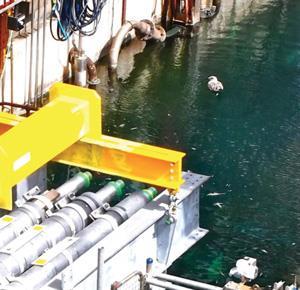
Randall explains with confidence that the company know both what went into the pond and what of this was not recycled, but acknowledges the sludge is constantly evolving with time.
That hasn’t stopped attempts to characterise it, however. ‘One of the great advantages of radioactive materials is that they are relatively easy to analyse,’ explains Randall. ‘You’ve got things like gamma spectroscopy where you can look at the emission spectra. You need very little material in order to do that.’
The UK’s National Nuclear Laboratory (NNL), based on the Sellafield site, has analysed sludge samples using well-established techniques, such as electron microscopy, to understand its composition. The pond’s 1500m3 of sediment contains varying amounts of the minerals brucite, artinite and hydrotalcite, with aluminium and other solubilised radionuclides, such as strontium and caesium, also being present. Water is overwhelmingly the main component of the silt at approximately 80%, and a 4% fraction is taken up by the long-discarded uranium metal.
Randall cautions that the sludge’s contents will vary depending on where they are in the pond and that uncertainty is exacerbated by the limited access to the site. ‘It’s not very easy to get to everywhere – any sampling campaign that we have done is somewhat constrained by access,’ he says. ‘That gives us markers, but doesn’t necessarily tell us the whole picture.’
One way chemists are attempting to break down this complex picture and to avoid the hazards of interacting with the pond is by compartmentalising it in the safety of a computer modelling lab. NNL currently use a process modelling platform called gPROMS to simulate the surface chemistry happening in the bowels of the FGMSP. The sandy bed of sludge is full of surfaces, and the lab is able to determine how a handful of radionuclides interact with the surface of the corroded uranium within the sludge.
Rather surprisingly, it appears that the strontium and caesium swimming around in the pond may not be too problematic to deal with. The models have shown strontium and caesium may adsorb to corroded uranium, possibly removing some of it from the aqueous phase.
But, as Randall highlights, corrosion is largely viewed as a negative thing in the context of the FGMSP. ‘Sellafield is close to the sea,’ he explains. ‘It has been known to be windy and it has been known to rain. This complicates the corrrosion conditions. The sum total of all that is you have corrosion products there and the detail of that, we do have gaps in our knowledge.’
Corrosion generates sediment that is problematic to both handle and characterise. It’s also a process that is tough to stop, given that the pond is open to the elements – and rainwater can lead to the lowering of the FGMSP’s pH through carbonation, for instance. But the team can attempt to pull the brakes on the corrosion process.
To do this, Newland and his team pump alkaline liquor into the storage pond in attempt to prevent the water from turning acidic. ‘We keep the pond alkaline to minimise the corrosion of the metal materials that are in the pond,’ he says. The 140,00m3 of contaminated water is kept at a pH of approximately 11.5.
A blooming problem
On top of trying to constantly counter the inevitable march of corrosion, researchers and engineers have yet another problem to contend with that any pond owner can relate to. ‘Being an open pond we do have a developed ecosystem,’ says Newland.
Without the ability to regulate the weather, local air temperature or atmosphere, airborne nutrients from local farms or the sea are free to be absorbed by the contaminated water and one organism is more than willing to feast upon them.
‘[The ecosystem] is very niche given the alkalinity of the pond,’ explains Newland. ‘But it does cause algal blooms.’ Such explosions in algal activity within the FGMSP can happen in the summer months between May and October each year. These blooms result in a problem with visibility in the pond.
Being an open pond we do have a developed ecosystem
With biomass in Sellafield site ponds masking the radioactive contents that lie beneath, it only adds to the frustration of trying to deal with this challenge. As Morris points out, ‘At the point that you’re not able to see into the pond, that then affects decommissioning.’
Irrespective of scientists’ inability to see the pond’s contents through opaque clouds of organic material, the situation demands an urgent remedy and Sellafield is not content to leave the waste there for another three decades.
Kidney transplant
The first step in Sellafield’s strategy is to purge the pond of the radioactive water. Attached to the outer periphery of the FGMSP, sits an eight tonne purging unit that provides a supply of clean alkaline liquor to the pond.
‘As we are starting to move waste, we’re stirring up the pond,’ explains Newland. ‘We are solubilising materials – that’s manifesting itself in an impact on the effluent stream.’ This means the conditions of the purge must be constantly adjusted to accommodate for the dynamic nature of the pond.
Once removed, the effluent is pumped through to the Sellafield ion exchange plant (SIXEP), or, as Newland calls it, the ‘kidneys of the site’. In one of Sellafield’s most crucial organs, the wastewater is subjected to a number of cleaning operations that remove the highly soluble radioactive contaminants, strontium and caesium.
The effluent is initially passed through a columned cascade of sand filters, which quickly remove any suspended solids that may have reached SIXEP. Carbon dioxide is dissolved in the liquor to lower the pH and only then is the wastewater ready for ion exchange.
It’s a relatively simple method of ‘scrubbing’ the water using beds of the naturally occurring absorbent clinoptilolite – a microporous, aluminosilicate mineral. Made up of a complex 3D network of silica and alumina tetrehedra, the zeolite is microporous and has a strong affinity for both caesium and strontium.
In the final stage of SIXEP, the soluble radionuclide cations in the liquid phase are exchanged with the silicon and aluminium repeating units to form part of the solid clinoptilolite phase. It’s rather effective, but you also generate new streams of solid waste that have to be dealt with. The clean water however can now be pumped into the Irish Sea.
Draining the dregs
And while the nuclear industry is still wrestling with this radioactive water, it is also turning its attention to the contamination conundrum of the sludge and waste fuel. Often the complexity of a scientific problem calls for a solution of equal intricacy and yet the industry’s answer is rather simple.
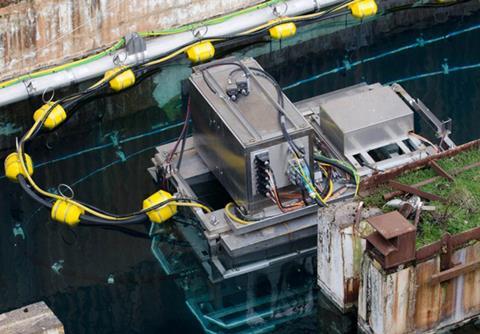
‘We’re retrieving sludge hydraulically through centrifugal pumps,’ Newland explains. Perhaps pump is a modest term for the contraption currently floating around FGMSP. The ‘sludge retrieval machine’ is a remote-controlled floating platform that has its own thrusters and an on-board camera system to help operators navigate the murky waters. To the untrained eye, it doesn’t look too dissimilar to the automated cleaners you see gracing swimming pools after hours.
There is critical reason as to why this robot is consigned to a solitary dance around FGMSP, however. Newland and his deputy Bruce Rigby are in firm agreement that any operation must minimise plant workers’ exposure to the harmful radiation emanating from the pond. The robot allows engineers to sit in the safety of a remote location without having to stand on the precipice with a cleaner in hand.
With the pump coming into operation in March 2015, the sandy radioactive dregs are now being directly siphoned into a state-of-the-art sludge packaging plant (SPP1). All of the pond’s contents will be deposited in three stainless steel vessels, weighing 240 tonnes each and standing at one and a half times the height of a double decker bus. Smaller steel components have been welded together to create these monoliths. If you were to trace your finger over the weld on one vessel, you’d end up having to walk just over a mile.
Uncharted waters
The steel containers are rather impressive structures, but they are containers nonetheless and only serve to confine the waste to a specific area. From a chemical perspective you would believe nothing has changed, but in moving the sludge from one environment to another you are introducing a new set of challenges.
‘We’re suddenly diluting the sludge because previously it’s been in beds at the bottom of the ponds,’ says Newland. ‘It will be transported hydraulically down a pipeline, which means a lot of water [and] a new equilibrium in that transfer. It will then go into SPP1, which will set up a new equilibrium because it’ll be different from the pond.’ The key point during this process, he explains, is to ensure that hazardous species within the effluent remain insoluble as they were within the pond originally.
While decommissioning of the FGMSP has now started in earnest, there is a huge question that remains unresolved: what will happen to the waste in those containers? Public concerns are complicating finding an answer, but the nuclear industry are confident the sludge will join the rest of the UK nuclear waste inventory and be locked in the depths of a future underground waste repository.
One thing is crystal clear – unlike disposing of the seagulls that may have bathed in the waters of the Sellafield pond, radiochemists and engineers are now facing up to a challenge that will not be at all simple to resolve.
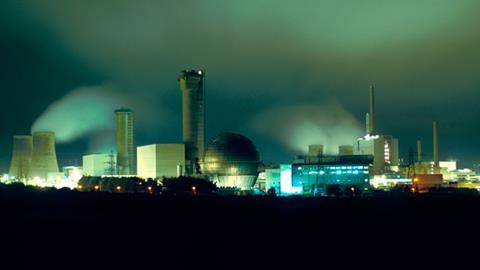
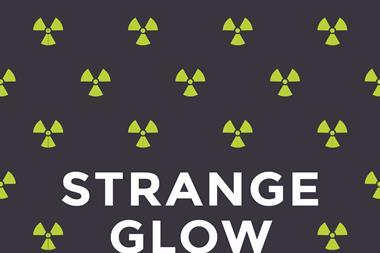
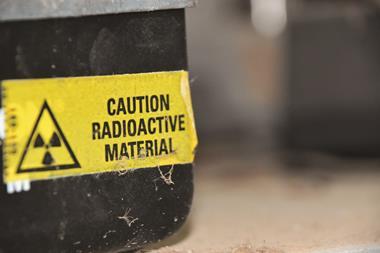










No comments yet